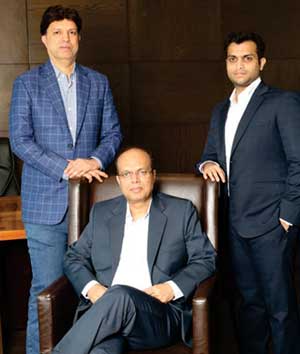FW
"Online retail is gaining strength when it comes to intimate wear purchase, reveals a recently released report by One Click Retail. The report states women who feel ‘awkward’ buying bras and underwear at brick-and-mortar retailers are now ringing up their lingerie purchases online instead, and this is helping Amazon gain market share. In 2016, the total value of the US apparel market — both online and offline — was $200 billion, with Amazon claiming about $3.4 billion of that, One Click Retail said."

Online retail is gaining strength when it comes to intimate wear purchase, reveals a recently released report by One Click Retail. The report states women who feel ‘awkward’ buying bras and underwear at brick-and-mortar retailers are now ringing up their lingerie purchases online instead, and this is helping Amazon gain market share. In 2016, the total value of the US apparel market — both online and offline — was $200 billion, with Amazon claiming about $3.4 billion of that, One Click Retail said. While total US apparel sales climbed 3 per cent last year, Amazon's apparel sales in the US saw a 25 per cent increase over the same period.

The top-performing apparel categories on Amazon.com in 2016 included men’s bottoms, which pulled in $375 million in sales; women's intimate apparel, which boasted $250 million in sales; women’s denim, with revenue of $170 million; and men's underwear, with sales of $165 million, according to data from One Click Retail. “Our data shows that the company is having great success with necessities and everyday items such as jeans, socks, underwear and men's work clothes,” the report said. Though, in their efforts toward a hassle-free shopping experience, Amazon is investing in innovation: in payments, order fulfillment, product selection and now, with Amazon Prime Wardrobe, return policy flexibility.
Prime Wardrobe
In order to ease shopping experience, Amazon has launched Prime Wardrobe, a new fashion platform, which looks similar to other wardrobe subscription services like Stitch Fix and Trunk Club. According to Amazon's website, Prime Wardrobe includes brands outside of Amazon's private labels, for example, Adidas, Calvin Klein, Levi's and Hugo Boss. The service allows customers to order items like shoes, clothes or accessories at no upfront charge, only paying for what they decide to keep. Shoppers have seven days to decide what they don't want.
Amazon’s share in the US
Amazon still boasts of a 5 per cent share of total retail sales, excluding food, across the country, according to data from the US Census Bureau. But Amazon's share of retail sales across the US in key categories — sporting goods, clothing, personal care and electronics — will only continue to accelerate from here.
Considering that department stores, discount stores and specialty stores remain the top store formats where women shop most often for clothes, Amazon might place its bet on real estate heavy acquisition, according to a recent research report from Fung Global Retail & Technology.
Sahib Mammadov, Azerbaijan’s deputy economy minister says that an association of textile producers and exporters was being established in Azerbaijan. The minister said textile industry entrepreneurs unanimously approved this initiative and went on to elaborate that the establishment of such an association would accelerate the process of making appropriate/necessary decisions targeted at the development of this segment. The minister was of the view that such associations served to improve relations between the state and the private sector. He further disclosed that there were already eight associations in the country and today was the establishment of the ninth association.
Arif Mardanov, Executive Director of the Baku spinning and weaving factory felt that the association must solve a number of problems in this segment. One of the main problem was lack of production of raw materials for the industry as over 70 per cent of raw materials were imported from foreign countries. He noted that despite the fact that they have recently increased production of cotton, the quality left much to be desired and everybody should work hard to resolve this issue.
The Alliance for Bangladesh Worker Safety that during the month of June 10 additional Alliance-affiliated readymade garment (RMG) factories completed all material components outlined in their Corrective Action Plans (CAPs), bringing the total number of factories to have completed their CAPs to 92.
Alliance Country Director Jim Moriarty commended all these factories for making workplace safety a top priority and encouraged them to work together to make safer garment factories the rule and not the exception in Bangladesh.
The Alliance also continued to enforce accountability measures for factories that failed to make adequate remediation progress. In June, two factories were suspended from the Alliance compliant factory list, bringing the total number of suspended factories to 156.
The Alliance is working with worker organisations, factory owners, NGOs, civil society, technical and engineering consultants, industry associations, educational and training institutions and the government of Bangladesh to ensure that safety improvements are technically sound, impactful, and sustainable.
Over 50 per cent of the UKs clothing market has achieved a 10 per cent reduction in carbon emissions following a collaborative agreement with Waste & Resources Action Programme’s (WRAP), Sustainable Clothing Action Plan (SCAP), a new report reveals. As of today 20 per cent more cotton is now sustainably sourced by signatories. With high-street brands like M&S, Tesco and Sainsbury’s setting ambitious sustainable cotton targets, this will help ease the pressure on some of the world’s most water-sensitive countries.
The update lists a number of priority garments for brands and retailers to target, as they have the highest environmental costs to manufacture. Women’s dresses, jumpers and jeans were at the top of the list, followed by men’s T-shirts and jumpers. Water used to make cotton is 60 per cent of the total water footprint of fabric processing, outweighing cotton’s 43 per cent. Companies are taking steps to promote sustainable cotton sourcing and WRAP is calling on organisations to set a 70 per cent target for sustainable cotton sourcing by 2020.
Primark has helped rural female farmers in India increase average profits by 247 per cent through the third year of its Sustainable Cotton Programme. WRAP is targeting 60 per cent household washes to run at a lower 30C setting by 2020, a habit which has become more prominent since 2012. Elsewhere, a decline in the use of tumble dryers and ironing has reduced emissions of clothes in circulation by 700,000 tonnes annually. SCAP is plying a major role in helping to make sustainable fashion much more mainstream.
Versaperm, the world leader in measurement of vapour permeability and other instruments, testing service and consultancy leader, has developed a system for ISO fabric testing that significantly reduces testing time down to as little as thirty minutes for many fabrics.
The system has been designed to be used for both product development and quality control of fabrics and garments. It is ideally suited to textiles that need to permit the passage of water vapour — breathable — but strongly resist both water droplets and wind.
Following the successful $200 billion market for active wear, demand for new high performance textiles puts textile producers under considerable stress to introduce even more smarter fabrics. A drawback is that ISO fabric testing can take several weeks to make even a single permeability measurement which adds a huge time lag into the process.
Versaperm says that its latest range of equipment can test several fabrics at exactly the same time and to an accuracy in the Parts Per Million (PPM) to Parts Per Billion ranges. Further, unlike ISO standard systems, Versaperm’s equipment can also measure vapour permeability of multiple gasses such as oxygen and water vapour through the same sample at the same time.
Ricoh will make available two new direct-to-garment printers, the Ri 3000 and the Ri 6000. The two devices give printers flexible and cost-effective digital systems traditionally serviced by analogue equipment.
The new direct-to-garment printers are ideal for promotional items like T-shirts, cloth bags, hoodies, sweatshirts, and socks, says Vaughan Patterson, product marketing operations manager for Production Print at Ricoh SA. Both can print on a wide range of materials from 100 per cent cotton and light polyester to mixed polyester and even 50/50 blends.
Screen printers, specialist direct-to-garment printers, sign and display printers, commercial graphic arts printers, and entrepreneurs can create valuable products for many industries, as well as fashion, education, corporates, small and medium businesses, home decoration, youth groups, sports clubs, and charities.
One of the key benefits of the digital direct-to-garment devices is that it shortens traditional production processes in this environment, says Patterson. They get colourfast, machine-washable prints that stretch without cracking. And the ink is environmentally friendly. It also integrates the process with the rest of the print workflows. Printers can get low volume, personalised jobs finished to high quality specifications on light and dark garments without limiting half tones, dumbing down their designs, and even using photographs.
The systems also include user-friendly maintenance features such as an automatic ink circulation system for white channels that improves ink flow and performance. It also incorporates the seven-inch touch-enabled panel. The printers will be progressively available throughout Europe and South Africa from the third quarter of 2017.
Fashion forecaster MintModa and Archroma, a global leader in color and specialty chemicals, now have a strategic partnership leveraging the respective strengths of both companies in color creativity. Combining Archroma’s scientific color expertise with MintModa’s clear, narrative-driven color forecasts provides fashion and design-related industries with an actionable and trend-right color resource.
Because color plays a starring role in visual language of social media, carefully chosen palettes are essential for capturing a new generation of connected consumers also color Atlas by Archroma offers 4,320 new shades, extending their custom color business with a readily available, time-efficient color management system. MintModa’s ColoRevolution offers highly-curated color analysis and direction on its cloud-based subscription trend service.
MintModa founder and creative director Sharon Graubard says the customer is visually sophisticated, a voracious consumer of ever-changing images depicting highly-styled products, places and people. The emotional draw of color, hardwired into humans, becomes an ever-more powerful marketing tool.
The Color Atlas by Archroma represents a true labor of love, says Chris Hipps, Global Director, Archroma Color Management. The idea is to offer our customers options they never dreamed of. In fact, the level of color curation dovetails with the passionate drive and relentless commitment towards excellence, he added.
Lectra the world leader in integrated technology solutions dedicated to industries using fabrics, leather, technical textiles and composite materials is now helping pattern-making students in Italy benefit from cutting-edge technology and nurtures key skills. It has chalked out partnerships with over 850 fashion schools across the world, providing them with solutions and expertise to help teachers prepare students with the skills they require for the workplace. Working with leading education partners, Lectra organises regular student competitions in association with customers.
The latest venture in Italy is a clear example of industry and education working hand-in-hand to nurture young fashion designers. Students at Istituto Secoli developed their collections using Lectra’s Modaris and Diamino solutions to create their patterns, prototypes and markers. In addition, students from the master’s program in menswear cut their creations with Vector, Lectra’s state-of-the-art fabric cutting solution.
Lectra serves major world markets: fashion and apparel, automotive, and furniture as well as a broad array of other industries. Lectra’s solutions, specific to each market, enable customers to automate and optimize product design, development, and manufacturing.
With more than 1,550 employees, Lectra has developed privileged relationships with prestigious customers in more than 100 countries. It registered revenues of 288 million dollars in 2016.
Telengana government has decided to discourage cotton cultivation. At present, 2.6 lakh hectares is under cotton cultivation and the government proposes to restrict it to 6.5 lakh hectares across the State this kharif season. The government is looking at promoting cultivation of pulses, millets and oilseeds by offering a 75 per cent subsidy.
Last year as well, the State government had asked farmers not to cultivate cotton in the areas that are not suitable for growth. The government announced farmers can grow cotton in about 4.75 lakh hectares that is suitable for the crop. Farmers grew cotton in 6.75 lakh hectares 2015, down by 1.25 lakh hectares from the 8 lakh ha. in 2014.
Last year, Telangana was first to discourage cotton cultivation which was soon followed by Andhra Pradesh due to pink bollworm infestation which developed a resistance to Bollgard II resulting in a 30 per cent drop in yield. The government was hence looking at reducing cotton cultivation by at least by 33 per cent and decided to promote pulses and millets as alternative crops.

Donear has acquired Grasim Bhiwani Textiles. The acquisition will give the Donear Group world class manufacturing capabilities, an iconic fabric brand and access to marquee customers globally. It will significantly enhance Donear’s product portfolio, give it access to a strong nationwide retail network, wholesalers and multi-brand outlets through which Donear can expand its reach.

Grasim is the country’s largest manufacturer of PV and PW suiting, selling its products under the Grasim and Graviera brands in India and abroad. The biggest strengths of Grasim Bhiwani are its quality-conscious trade partners and global customers, who have been associated with it for a long time.
Grasim Bhiwani caters to international fashion houses in the US and the UK, supplying fabric to them for making garments. These garments are available in some of the largest retail chain stores. Donear aims to build further on Grasim’s existing strengths. Both Donear and Grasim Bhiwani will maintain their individual identities and stay committed to offer the best products and services to their valued customers as one team.
Textile is Donear’s core business. It has a production capacity of around 45 lakh meters a month. Donear also has a strong international presence. With a comprehensive product basket, the company is supplies fabrics to India’s largest brands including Louis Philippe, Van Heusen, Peter England, Blackberry, Arvind, Wills Lifestyle and more.











